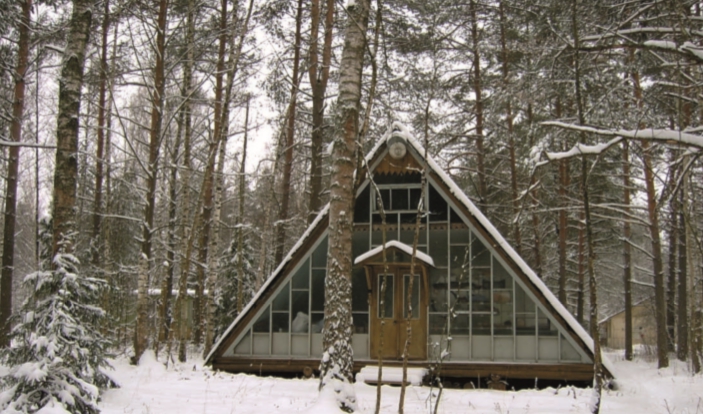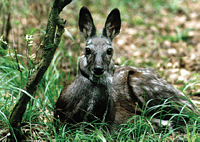CHERNOGOLOVKA BIOLOGICAL STATION
Head of the station: V.V. Rozhnov, academician of the RAS
Head-manager G.V. Tarasov

MAIN AREAS OF STUDY

One if the main buildings of the SEB Chernogolovka

Experimental fenced testing grounds for studying social behavior of small carnivorous mammals

A special center has been established to study the causes of the disappearing of the European mink and its conservation

Musk deer - a species for which the technology of musk collection in their lifetime has been developed

Experimental testing ground for studying the social behavior of voles

Red vole - one of the objects of social behavior research

Complex for studying behavior and reproductive biology of Russian desman
The scientific and experimental base "Chernogolovka" is located in the Noginsky district of the Moscow region (60 km north-east of Moscow), on the territory of the Chernogolovsky Scientific Center of the Russian Academy of Sciences, 4 km from the city of Chernogolovka, in a forest, on two sites with a total area of 40 hectares. The base was organized in 1975 (order of the Presidium of the USSR Academy of Sciences No. 125000-1018 dated June 25, 1975) on the initiative of Academician V.E. Sokolov for a comparative study of the behavior and chemical communication of wild mammals under conditions as close as possible to natural ones. The staff of the laboratory of behavior and behavioral ecology of mammals, headed by the scientific director of the base, doctor of biological sciences V.E. Rozhnov, work at the base constantly. Experimental studies of the communicative and social behavior of terrestrial mammals and the biology of reproduction are carried out throughout the entire year; methods and technologies for keeping and breeding rare mammals are being developed.
The base has a unique living collection of land mammals with a total number of about 2000 individuals. Among them are predatory (mustelids - ferrets, minks, sables; viverrids - musangs, genets; felines – lynxes, small felines), ungulates (musk deer), insectivorous (hedgehogs, desman), rodents (forest voles, gray voles, mice, gerbils, house mice , hamsters, guinea pigs), lagomorphs (rabbits), chiroptera (bats).
For different species of mammals, special complexes of aviaries and polygons have been built, most of them unique:
- a complex of enclosures and experimental polygons for small carnivorous mammals (fifteen closed enclosures from 3 to 30 m2, two polygons of 40 m2 and two polygons of 120 m2 each, consisting of three transformable compartments, a large-sized enclosed installation "open field", two large open areas aviaries, two covered sheds with individual cages for 45 seats);
- a complex of enclosures for lynxes and small cats (closed cages for 28 seats of 4-8 m2, six open enclosures of 74 m2 each, two open enclosures of 0.5 hectares);
- a complex of enclosures for dogs (one enclosure 130 m2, three 300 m2 each, one 360 m2, one 420 m2, one 700 m2 and one 1400 m2); complex of open-air cages for musk deer (seven open-air cages with a total area of about 5 hectares);
- a chiropterological habitat (a large enclosed enclosure, the so-called wintering "cave" and a complex of auxiliary buildings);
- an vivarium-aviary complex for insectivores (special cages for 20 seats, open aviaries of different sizes);
- complex of aviary and pools for desmans;
- - an experimental complex of grounds for rodents (indoor polygonal enclosures of 120 m2 with three transformable compartments for seasonal observations, open-air grounds of 240 m2 with six transformable compartments for seasonal observations, two closed polygons of 120 m2 with two convertible compartments for year-round observations);
- three laboratory-vivarium complexes for rodents (one - for 1000 enclosures and a set of laboratory equipment; the second - for 500 enclosures, an open experimental ground of 100 m2; the third - also for 500 enclosures);
- laboratory-vivarium complex for house mice (300 enclosures, aviaries);
- laboratory-vivarium complex for desert rodents (special cages for 200 seats, 1 m2 chambers, two open enclosures 200 and 400 m2).
The Chernogolovka station of IEE RAS maintains several specialized laboratories:
- video laboratory for documenting and analyzing mammalian behavior (video surveillance system "Observer" with licensed software, digital video cameras, computers, video recorders, television monitors),
- acoustic laboratory for research of acoustic communication (recording devices - professional digital two-channel audio tape recorder Tascam Teac Professional Division DA-P1 with a range of recording frequencies from 20 Hz to 20 kHz, a Sennheiser K6 condenser microphone with a frequency range from 20 Hz to 20 kHz, an equalized characteristic of 500 Hz -20 kHz and 1 kHz sensitivity 0 dB, Sennheiser 416P 48U narrow-beam microphone with a frequency range from 40 Hz to 20 kHz and a capture angle at a sensitivity at 1 kHz of 0 dB 450; a computer equipped with a professional DMX 6fire sound card for processing and storage of a audio library - a collection of mammalian voices of more than 100 species, subspecies and populations; licensed program for recording and analyzing sound signals Saslab Pro version 4.2),
- cytogenetic laboratory (microscopes, centrifuges, photographic equipment),
- ecological and physiological laboratory for determining the concentration of hormones by enzyme immunoassay (multiscan EX slide spectrophotometer with variable wavelength and software for measuring optical density and concentration measurement, automatic washer for slides StatFax-2600, Elmi shaker-thermostat for plates, mixer Ekros- 6500, Elmi centrifuge for Eppendorf tubes (up to 15,000 rpm), Elmi shaker, Heidolph magnetic stirrer, Labsystem stepper, Ohaus electronic balance up to 200 g with an accuracy of 0.01 g, Mettler-Toledo portable pH meter, Gilson automatic pipettes variable volume, refrigerators and freezers for storing samples, a diluter, a semen analyzer for monitoring the quality of semen of breeding mammals),
- laboratory of field equipment for studying the behavioral ecology of mammals in the wild (night vision devices Dedal-45, equipment for radio tracking of mammals - Yaesu FT-817nd radios with three-section YHA-63 antennas, Nikon Coolpix3200 digital cameras for photographing mammalian footprints and subsequent individual identification by computer programs, GPS navigation devices, sensors for long-term measurement of temperature and humidity in mammalian burrows).
The existing scientific and technical equipment of the base allows for a much wider range of scientific research than the study of only the social and communicative behavior of mammals. Together with specialists from other departments of the Institute, as well as colleagues from other research institutions in Russia and other countries, research is being carried out on taxonomy, hybridization, ecological physiology, endocrinology, and morphology of the outer cover layers of terrestrial mammals.
To preserve rare species of mammals, the Center for the Conservation of the European Mink, the Center for the Conservation of the Desman, and the Farm for the Breeding of Musk Deer have been established.
The use of a unique living collection of mammals, modern scientific equipment by specialists from many scientific institutions made it possible to create a Center for Shared Use - "Center for Ecological and Ethological Research" Chernogolovka "(on the experimental base of the Severtsov IEE RAS)".
SCIENTIFIC CENTER
Since 1997 the IEE RAS base "Chernogolovka" established a Joint Educational and Scientific Biological Center between the A.N. Severtsov RAS Institute of Ecology and Evolution, M.V. Lomonosov Moscow State University, and Moscow State Pedagogical University (UC "Chernogolovka" IPEE RAS) (through bilateral agreements); in addition, at the IEE RAS UC "Chernogolovka", students of the following basic universities of the region carry out their term papers and theses:
M.V. Lomonosov Moscow State University;
Moscow State Pedagogical University;
Russian State Agrarian University - Moscow Timiryazev Agricultural Academy;
K.I. Scriabin Moscow state academy of veterinary medicine and biotechnology;
D. Mendeleev University of Chemical Technology of Russia (D. Mendeleyev University, MUCTR)
Tula State Lev Tolstoy Pedagogical University;
Samara State University;
Tver State University;
Novosibirsk State University
A new base department was created at the scientific and experimental base "Chernogolovka" IEE RAS in 2006, - a branch of the Department of Zoology of the Russian State Agrarian University - Moscow Timiryazev Agricultural Academy (through a bilateral agreement).
The base has a complex of premises for accommodation of personnel, invited specialists and students, equipment and materials - 14 buildings with a total area of more than 2000 m2. To ensure the maintenance of animals, there are warehouses, refrigeration equipment, equipment for processing and preparation of feed, production workshops. The operation of the base is provided by the manager and production personnel.
